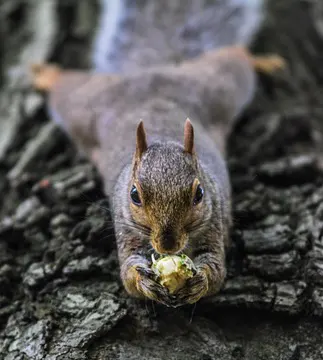Have you noticed the absence of squirrels in your yard during the winter months? Are you wondering what happened to them? Where did they go? Do squirrels hibernate in winter?
Let’s explore what exactly these nimble raiders of all things seed are up to during our cold season.

Torpor vs. Hibernation
First, let’s look at Torpor vs. Hibernation. Torpor is a state of rest or inactivity that lasts only a short time (like one day or night). It is basically a VERY deep sleep, during which heart rate, body temperature, breathing and metabolic rate are lowered. It appears to be involuntary.
Hibernation, on the other hand, can last for several weeks or even months and is a deliberate state, meaning that the animal prepares for and enters into it voluntarily. Both torpor and hibernation are survival tactics for when food is scarce.
So, when do squirrels hibernate? Or, do squirrels hibernate for winter?
Squirrels and Seasonal Behavior
Squirrels do not hibernate. They can enter a state of torpor, though. Weather permitting, they may venture out to retrieve a stash of goodies collected earlier in the year. Below is a closer look at squirrel activity and behaviour across our seasons.
Spring
Ahh yes… Spring! This is a busy time of year for most animals. Spring marks the beginning of breeding season for squirrels and most other mammals in our Northern climate. Squirrels of all ages engage in mating rituals and courtship. Moms-to-be construct nests, also known as dreys, in trees in anticipation of giving birth and raising their young. After a long winter, squirrels also become active in their foraging, searching for nuts, seeds, fruits, and plants.
 Summer
Summer
Squirrels are generally more active and busy during long summer days, which allows for gathering food, raising their family and making friends with the neighbours. Squirrels are very social creatures and chitter chatter to each other frequently. This is also a time to be vigilant and on the lookout for predators.In addition to seeking out shade, squirrels are avid groomers and spend much time cleaning and maintaining their coats, which may aid thermoregulation. Despite increased activity during the summer months, squirrels are quite efficient at conserving energy to ensure their survival and reproductive success.
Fall/Autumn
Our harvest season is one of the busiest for the squirrel as well. As winter draws close, squirrels spend the majority of their time preparing for the coming months. They skillfully gather and stash food such as nuts and acorns to ensure sustenance throughout harsh winter conditions.
Winter
Winter is a time to rest. For several hours squirrels may enter a state of torpor. Much shorter than hibernation, torpor still aids in preserving energy by lowering body temperature, heart rate, and metabolism. They’ll dash out to retrieve food that has been stockpiled the months before, then return to their nest in tree cavities and other sheltered places.
Factors Influencing Squirrel Behavior
Weather
Some more comical likenesses of squirrels show them splayed out on their bellies, with limbs stretched straight out. This behavior is called ‘splooting’. It aids in cooling down their little bodies in sweltering heat. Of course, winter sees squirrels tucked away in a safe and sheltered location with little activity, save for a quick dash to a food stash. Weather also has an effect on breeding; during abundant years, females may bear 2 litters.
Habitat
Urban squirrels are both spoiled and resourceful. While more food can be gathered quicker than in the wild, there are added dangers when living in the city. Urban squirrels frequently find themselves dodging automobile traffic and domestic pets putting on a chase.
Predators
In rural areas and natural squirrel habitats, hawks and owls are likely the biggest threats. They are closely followed by fox, coyote, the occasional wildcat, and weasels. What may be surprising is that squirrels also need to be on the lookout for snakes. In an urban setting, it’s probably domestic pets like cats and dogs that are most disturbing a squirrel’s peace.
Nutritional Needs
Squirrels rely on a diverse diet for survival. In addition to the expected nuts, seeds, and fungi, they also consume insects, tree bark, bird eggs, and buds when available. Wild squirrels have a balanced diet of proteins, fats, and carbohydrates and a range of vitamins and minerals. This includes Vitamin C, Calcium, and Iron.
Mating
Squirrels engage in a process of courtship and mating that involves female mate choice. A female squirrel, 10 - 12 months and older, will run off and engage the males in a mating chase within her territory. A type of hide and seek, if you will. Typically, the dominant male will find or reach the female first and then mate with her. The gestation period for the eastern gray squirrel (Sciurus carolinensis), found in Canada, is about 44 days and females can bear 2 litters in one year..Squirrels are polygynandrous; both males and females may mate with several partners. The female takes on sole responsibility for parental care of her young.
Squirrel Stuck In Your Yard? Call Hawkeye!
If your resident squirrel(s) have moved into your home, your shed, or pitched a tent under your deck, and none of the natural squirrel repellents you've tried worked, you may need to involve the experts. Professional wildlife removal specialists will help with getting squirrels out of your space and assess damage to your structure, insulation, and wiring. More on Squirrel Removal here »














